![]()
![]()
![]()
Use LEFT and RIGHT arrow keys to navigate between flashcards;
Use UP and DOWN arrow keys to flip the card;
H to show hint;
A reads text to speech;
47 Cards in this Set
- Front
- Back
|
Cranial |
Superior, nearer to head |
|
|
Caudal |
Inferior, nearer to feet |
|
|
Ventral |
anterior nearer to front |
|
|
Dorsal |
posterior, nearer to back |
|
|
Supine |
Lying on back |
|
|
Prone |
Lying on chest, face down. |
|
|
Proximal |
Nearer to trunk or point of origin. |
|
|
Distal |
Further from the trunk or point of orgin
|
|
|
Coronal |
frontal plane, vertical plane passing through the body at right angles to the median place dividing it into front and back. |
|
|
Sagittal |
Vertical plane that is parallel to the median plane. |
|
|
Transverse |
Horizontal, at right angles to the median and frontal planes. Divides body into superior and inferior parts. |
|
|
Medial |
Nearer to median plane.
|
|
|
Lateral |
Farther from median plane.
|
|
|
Superficial |
Nearer to or on surface. |
|
|
Deep |
Farther from surface |
|
|
Intermediate |
Between opposite pairs of terms above |
|
|
Dorsum |
Surface of hand, foot nose, or penis toward back in quadrupedal position.
ex: Veins are visible in dorsum of hand. |
|
|
Palm |
Anterior surface of hand |
|
|
Plantar |
Sole, inferior surface of foot. |
|
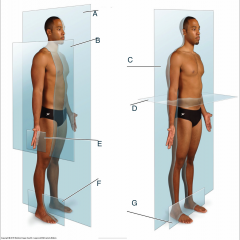
A? |
Median Plane |
|
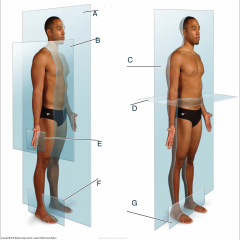
B? |
Sagittal plane |
|
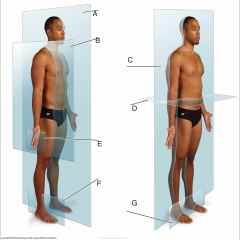
C? |
Frontal (coronal) plane |
|
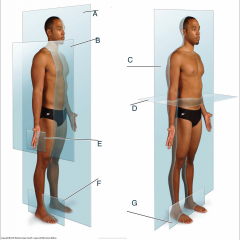
D? |
Transverse (axial) plane |
|
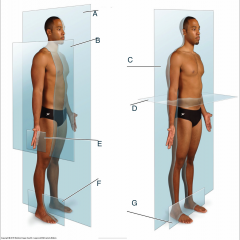
E? |
Median plane of hand |
|
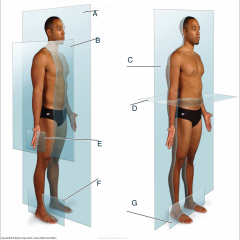
F? |
Median plane of foot |
|
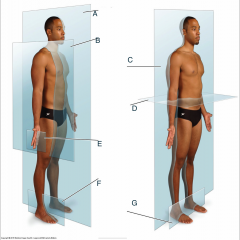
G? |
Frontal (coronal) plane of feet |
|
|
Intermediate |
Between superficial and deep |
|
|
Palmer vs. Dorsal |
Palmar: anterior hand (palm)
Dorsal: posterior hand (dorsum)
|
|
|
Plantar vs Dorsal |
Plantar: Inferior foot surface
Dorsal: Superior foot surface |
|
|
The midline of the hand is the________. |
Middle finger. |
|

Movement? |
Circumduction |
|

Movement A |
A: Pronation |
|
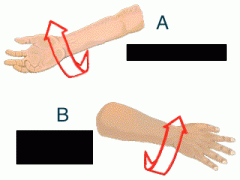
Movement B |
B: Supination |
|
|
Eversion vs. Inversion of foot |
Eversion: turning sole of foot outward
Inversion: turning sole of foot inward |
|
|
Abduction |
moving away from the median plane of the body in the frontal plane |
|
|
Adduction |
moving toward the median plane of the body in the frontal plane |
|
|
Rotation |
moving a part of the body around its long axis. |
|
|
medial rotation |
turns the anterior surface medially |
|
|
lateral rotation |
turns the surface laterally. |
|
|
Circumduction: |
movement of the limbs in a circular movement. |
|
|
Pronation |
medial rotation of the anatomical position |
|
|
Dorsiflexion |
elevation of the dorsum of the foot at the ankle |
|
|
Plantarflexion |
depression of the sole of the foot at the ankle. |
|
|
Protusion (protraction) |
moving the jaw anteriorly, outward. |
|
|
Retusion (retraction) |
moving the jaw posteriorly, inward. |
|
|
Elevation |
raises or moves a part superiorly |
|
|
Depression |
lowers or moves a part inferiorly |

